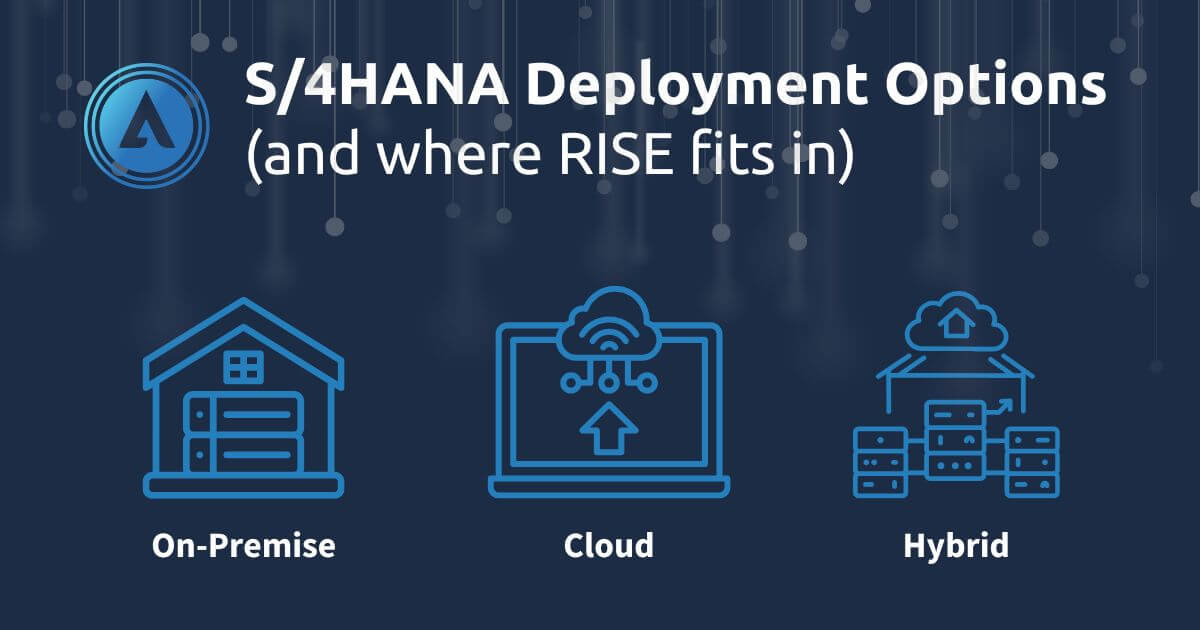Upgrading to SAP S/4HANA is a major milestone in your enterprise application services strategy—but it’s not just about the technology.
From choosing between on-premise, cloud, or hybrid ERP deployment models to evaluating broader transformation offerings like RISE with SAP, the decisions you make now can shape your business’s ability to grow, scale, and stay secure for years to come.
Whether you’re in manufacturing, healthcare, finance, or retail, your ERP deployment strategy should reflect your IT infrastructure, compliance requirements, and long-term digital transformation goals.
So which SAP S/4HANA deployment model is right for your business? Let’s walk through your options.
What About RISE with SAP?
If you’ve been exploring SAP solutions, you’ve likely come across RISE. Think of RISE as a bundled offering that helps accelerate cloud transformation by combining SAP S/4HANA with the tools, services, and support to simplify migration and improve performance.
But here’s the key: RISE isn’t a deployment model; it’s a flexible framework. You’ll still need to choose the right environment for your business: public cloud, private cloud, on-premise, or hybrid.
The rest of this article helps you weigh those options based on your infrastructure, compliance needs, and goals.
SAP S/4HANA Deployment Options: On-Premise vs. Cloud vs. Hybrid
1. On-Premise Deployment
SAP S/4HANA is installed on your own servers, giving you full control over updates, customizations, and infrastructure.
- Best for: Highly regulated industries (like healthcare and finance), businesses with heavy customization needs, or those with existing IT investments.
- Cost: Higher upfront investment in servers, licenses, and IT support.
- Scalability: Limited by your hardware; scaling requires physical upgrades.
- Compliance: Easier to manage internally, especially for strict data governance.
2. Cloud Deployment
Your ERP is hosted by SAP or another cloud provider like AWS or Azure. This deployment offers faster implementations, lower infrastructure overhead, and greater flexibility.
It’s also a common component of RISE, which bundles S/4HANA Cloud with tools and services to support broader business transformation.
- Best for: Companies seeking flexibility, faster innovation, and reduced CapEx.
- Cost: Subscription model with predictable OpEx. Fewer in-house resources needed.
- Scalability: Extremely high—you can adapt to demand quickly.
- Compliance: You share responsibility with the provider. Check certifications and SLAs carefully.
Need help navigating SAP in the cloud? Our Cloud Consulting Services team works with you to assess readiness, choose the right cloud environment, and support a secure, scalable deployment strategy.
3. Hybrid Deployment
Not quite ready for a full cloud migration? A hybrid ERP model gives you the best of both worlds, preserving legacy systems while modernizing where it matters most.
- Best for: Enterprises with legacy infrastructure, compliance variability, or a phased digital strategy.
- Cost: More complex but flexible. Can extend ROI on existing investments.
- Scalability: Moderate; scales faster than on-prem but slower than full cloud.
- Compliance: Sensitive workloads stay in-house while less critical functions leverage the cloud.
How to Choose the Right Deployment Model
So…how do you decide between on-premise and cloud for SAP S/4HANA?
It depends on your industry, compliance needs, existing systems, and business goals. Here’s a simple decision framework to help guide you:
Choose On-Premise if:
- You have strict data residency or compliance requirements.
- You’ve already invested in on-premise infrastructure.
- Your ERP is heavily customized and difficult to migrate.
Go Cloud if:
- You need scalability, faster deployment, and lower maintenance costs.
- Your business model demands agility and frequent updates.
- You lack the internal IT resources to manage on-prem systems.
Consider Hybrid if:
- You want to modernize at your own pace.
- You need to balance cloud innovation with legacy stability.
- Your organization is large, global, or spans multiple compliance frameworks.
- You’re using RISE with SAP and want flexibility between cloud and legacy systems.
Industry-Specific Deployment Trends
Manufacturing & Consumer Goods
Leaning into hybrid S/4HANA deployments, manufacturers often keep plant-floor systems on-premise while migrating analytics or supply chain modules to the cloud.
Retail & CPG
Retailers need agility, especially during peak seasons and sudden demand spikes. That’s why many are going cloud-first to stay nimble and competitive.
Healthcare & Insurance
Compliance often favors private cloud or on-premise systems for core applications, while hybrid models enable secure innovation in patient experience or customer portals.
Financial Services
Security and auditability remain key. Many choose SAP S/4HANA private cloud deployment to strike a balance between control and modernization.
For financial institutions evaluating broader transformation strategies, RISE with SAP can also offer a structured, compliance-ready path backed by bundled services and support.
Curious how companies like yours transition to S/4HANA and ensure post-go-live ROI? Read our blog: Beyond Go-Live: Maximizing ROI from Your SAP S/4HANA Investment
Why Hybrid ERP Deployments Are on the Rise
Not every company is ready to go all-in on cloud—and that’s okay.
Gartner predicts that by 2027, 90% of midsize enterprises will have adopted a hybrid ERP strategy. More than just a hedge; it’s a deliberate path that balances continuity with modernization.
What are the benefits of SAP S/4HANA hybrid deployment?
- Migrate in phases, not all at once.
- Keep critical legacy systems operational.
- Test cloud modules in real-world use cases.
- Gain cloud benefits without overhauling everything overnight.
For many companies, hybrid isn’t just a stopgap. It’s a smart, flexible strategy that supports long-term transformation without forcing an all-or-nothing decision.
Fun Fact: Artemis’ Business Intelligence & Analytics team often supports clients using hybrid models to bring real-time insights into cloud-hosted platforms.
Final Thoughts: Make ERP Work For You, Not Against You
No matter which deployment model you choose, your ERP implementation strategy should align with business goals, not just IT preferences.
Whether you’re optimizing for compliance, scalability, or speed—or rolling out S/4HANA as part of a RISE with SAP strategy—working with an experienced partner ensures your deployment becomes a growth driver rather than a frustrating roadblock.
Let’s work together to build a roadmap that fits your business, on your terms and timeline.
Need help mapping the right strategy?
From enterprise application services to SAP strategy consulting, Artemis can help businesses like yours design ERP deployments that perform today and scale for tomorrow.
Contact us to talk through which SAP S/4HANA deployment model aligns with your goals.






